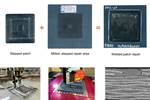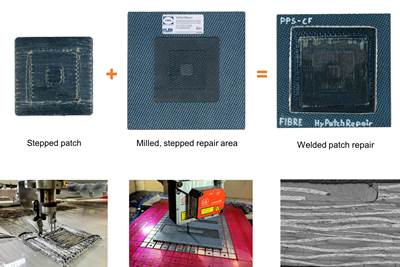MiniLab consortium produces first full-scale thermoplastic composite hydrofoils
Project advances toward first recyclable foils for ocean racing, part of “Infinite Foil” finalist for JEC Innovation Award 2025.
Victrex and MiniLab members beside the developed thermoplastic composite (TPC) hydrofoils. Source (All Images) | Avel Robotics, MiniLab
MiniLab is an open innovation ecosystem that connects public and private partners around full-scale demonstrator projects to develop and test technologies. The platform was founded in 2023 by Adrien Marchandise, co-founder and CTO of Avel Robotics (Lorient, France) to advance sustainability and reduce the sailing industry’s environmental impact.
Infinite Foil is one of MiniLab’s first projects, aimed to demonstrate the first recyclable composite hydrofoils for ocean racing (read “Breton companies launch recyclable hydrofoil design project”). This initial foil is sized for MiniLab’s in-situ testing lab — a Mini 6.5-meter regatta sailing vessel. Multiple foils will be produced and raced during the 2025 regatta season.
Infinite Foil project partners include:
- (Lorient, France) — Designs and produces carbin fiber-reinforced polymer (CFRP) hydrofoils using automated fiber placement (AFP)
- (Ploemeur, France) and (Lorient, France) — Technical innovation centers focused on polymers, composites, robotic AFP and additive manufacturing
- Diab (Helsingborg, Sweden) — Recycled and recyclable PET foam supplier
- Victrex — Supplier of LMPAEK polymer for high-performance thermoplastic composite (TPC) prepreg tape.
With the combined know-how of these partners, MiniLab has produced its first TPC hydrofoil on a scale representative of production parts. This demonstrator validates multiple elements:
- Required radius of curvature and accuracy of dimensions
- Best draping strategies and parameters for robotic AFP layup
- Ability to analyze and optimize the consolidation and molding process.
The finished part was then tested to measure the mechanical properties.
According to Marchandise, the 2025 program for the TPC hydrofoil includes:
- Integration of fiber optic sensors by partner (Lorient, France) to measure the level of strain LMPAEK can reach in extreme conditions without damage
- Acoustic emission sensors will be integrated by MiniLab in order to monitor in situ the potential damages the foil will encounter
- Mechanical testing of the foils via Southern Brittany University (Université Bretagne-Sud) bench test to validate elastic characteristic and to calibrate the sensors
First seal trials are expected in February of this year in Lorient, followed by first initial offshore qualification races between April and June. The definitive validation of the robustness of this material will be provided by starting Sept. 21, 2025, a single-handed ocean race across the Atlantic Ocean covering 4,000 miles.
Industry will be able to see the TPC hydrofoils in person at Avel’s booth at JEC 2025, as well as at one of the JEC Planets. “We’re looking for new sponsors to book the year’s budget to participate in the Mini Transat 2025,” Marchandise says.
In parallel with Infinite Foil, Avel Robotics has launched a larger foil project funded by the Region Bretagne with a new partner, Mer Concept (Brittany), that has just won the Vendée Globe for its IMOCA MACIF Santé Prévoyance, an IMOCA 60 monohull sailing yacht. “We’re going to develop a thermoplastic material with improved compressive strength,” says Marchandise. “Our goal is to start the scale up to industrialize thermoplastic composite foils for larger sailing vessels, and we hope to manufacture the first such foils for ULTIM or IMOCA class racing yachts in 2026/2027.” Each week through February 2025, Marchandise’ team will share a key stage of this technical and collaborative work.
For more details, see CW’s description of MiniLab in: “Composites End Markets: Boatbuilding and Marine (2025).” Those interested in the TPC hydrofoil project should follow on LinkedIn and visit the “Infinite Foil” project at , where it was a finalist for this year’s .
Related Content
Al Seer Marine, Abu Dhabi Maritime unveil world’s largest 3D-printed boat
Holding the new Guinness World Record at 11.98 meters, the 3D-printed composite water taxi used a CEAD Flexbot to print two hulls in less than 12 days.
Read MoreU.S. Coast Guard MBI releases report on Titan submersible
The two-year investigation into the June 2023 tragedy that took five lives has been published, citing key findings, contributing factors to the casualty and a recommended regulatory framework to avoid future oversight.
Read MoreHybrid composite architecture enables rigid wind propulsion solution for maritime decarbonization
GT Wings’ AirWing leverages aerospace engineering principles combined with hybrid glass and carbon fiber composite construction to deliver up to 30% fuel savings through compact, deck-compatible wind propulsion.
Read MoreDeveloping bonded composite repair for ships, offshore units
Bureau Veritas and industry partners issue guidelines and pave the way for certification via StrengthBond Offshore project.
Read MoreRead Next
Candela C-8 hydrofoil boat marks record trip across the Baltic
The electric vessel, claimed to be the first to cross the Baltic Sea, cuts traditional refueling needs in half, achieves 95% less operating costs, during the 150-nautical-mile journey.
Read MoreDeveloping repairs for thermoplastic composite aerostructures
HyPatchRepair project proves feasibility of automated process chain for welded thermoplastic composite patch repairs.
Read MoreCeramic matrix composites: Faster, cheaper, higher temperature
New players proliferate, increasing CMC materials and manufacturing capacity, novel processes and automation to meet demand for higher part volumes and performance.
Read More












